The M.U.S.C.L.E. Mega-Match Game is a very interesting part of Mattel’s M.U.S.C.L.E. brand. There are three important aspects that differentiate it from the rest of the line:
- It is the only core Mattel product not featured in their catalog.
- It was a M.U.S.C.L.E. item made in the United States of America.
- It features a unique set of Light Purple figures – a color not released in 4-, 10-, and 28-packs.
The Mega-Match board game was the only M.U.S.C.L.E. figure related item that did not appear in the 1986 Mattel catalog. It was not included in the M.U.S.C.L.E. section and it was not included in the Games section. The same scenario happened in 1987 – the board game was completely missing. Additionally, when the toy industry trade magazines were covering the new products for 1986 and 1987 the Mega-Match Game was never mentioned.
This lack of inclusion makes it more difficult to pinpoint an exact release date. The game elements are copyrighted 1986, but Mattel was already starting to see a decline in their financial solvency – which makes it unlikely they were sinking development dollars into a flanker brand that was not created internally at Mattel. Additionally, Martin Arriola had shared that the focus for Mattel had turned to Captain Power in 1986. This data strongly suggests that the game was not part of the initial release or Toy Fair release in 1986. It likely fell somewhere after the 1986 Toy Fair, but early enough before the 1987 Toy Fair to escape inclusion. Admittedly, this does not explain why it is not part of Mattel’s 1987 catalog – unless it was already discontinued.
The board game is effectively absent from any Mattel and M.U.S.C.L.E.-related documents of the eighties. This does not make the game an accidental oddity that reached the marketplace. The board game is actually very common and, to some degree, regarded as the least exciting aspect of the M.U.S.C.L.E. brand by many collectors.
While the game might not generate excitement, there are quite a few interesting aspects of the game. Original M.U.S.C.L.E. art from Mattel is quite rare, which makes the cover of the Mega-Match Game appealing.
The first oddity of the cover is the choice of the color for the figures. The box art would suggest Magenta and Green are the colors of the board game figures – perhaps this was the original intention. Instead the board game figures are Light Purple and Green.
It also appears that there may have been different figures originally selected for inclusion into the game, based on the artwork. The Magenta figures on the cover appear to be figures:
#31/140/200 (Some version of Terryman, Far Left)
#152 (Between #Terryman and #1)
#1 (Center)
#149 (Between #1 and #150)
#150 (Far Right)
There also seem to be some subtle changes with the Green figures too. The Green characters on the cover appear to be:
#178 (Far Left)
#2 (Center)
#180
#181 (Far Right)
The Purple figures included with the game were: #1, #149, #151, #152, and #154.
The Green figures included with the game were: a Green Wrestling Ring Terri-Bull, #177, #178, #180, and #181.
It seems reasonable that Mattel wanted their flagship characters #1 (Muscleman) and #2 (Terri-Bull) as the featured characters in the game. Apparently, someone at either Bandai or Mattel decided that using #2 wasn’t the best plan. It is unknown why the Green #2 from the cover was removed from the game.
Figure #177 is noticeably absent from the cover of the box. Perhaps this is why the potential Terryman (#31, #140, or #200) appears to be reacting to pain that is being induced by back spasms instead of a feared combatant. Mattel had made changes to their Pre-Pack art , perhaps this was a similar change. Did Mattel consider #177 too scary to be included on the cover of the box?
While the cover of the box focuses on the nine main figures in the foreground, there are still some M.U.S.C.L.E. figures that can be identified in the background. Moving from left to right the figures that can be identified are:
#204 – Tortle
#45 – Spring
#190 – Clam
#191 – Spikes
#184 – Hair
#212 – Building
#127 – Spikes
#120 – Merman
#186 or #230 – Spike/no head
#193 – Snake
#194 – Alien/3 spike
#85 or #217 – Kinnikuman Mummy “Zebraman”
Interestingly, the background character that is most prominent is actually the most difficult to identify. He has some type of helmet or mohawk, but doesn’t appear to be a Muscleman figure.
The back of the box is filled with interesting pieces of information gathered from five main areas. The first area is the picture of the figures in the top and bottom left corners. Unlike the 1986 Mattel catalog which appeared to use Kinnikuman figures in the picture, the back of the box appears to have 100% authentic M.U.S.C.L.E. figures – similar to their Mattel is Tougher picture.
The second piece of information is that even Mattel writers seemed to struggle with how to identify M.U.S.C.L.E. figures. The text refers to the figures as both things and creatures, as if it is unsure of the correct name. A problem that also seemed to plague toy industry writers. The copy also seems to conspicuously avoid labeling it a wrestling game, although wrestling related terms (match, championship showdown, battle, brawlers) litter the writing and every other piece of M.U.S.C.L.E. product features Muscleman jumping off the top of a wrestling ring.
Mattel has even chosen to label the stickers as “Press-On Labels.” This small choice seems to encapsulate many of the problems that overwhelmed the M.U.S.C.L.E. brand. Instead of appealing to children and mothers (the core buying audience at the time) with an understandable phrase that explained the stickers could be used for customizing the board game, Mattel chose “Press-On Labels.”
Continuing the questionable choices regarding the stickers/Press-On Labels, the picture showing the sheet of stickers is missing the largest stickers – the banner-type stickers. While four stickers can be seen on the board game it doesn’t explain why all of the banner stickers were used. Did the photographer decorate all the inside walls, and then choose to use the side that was least decorated? And did Mattel only provide one sheet of stickers to the photographer?
The Spinner can also clearly be seen, but this is certainly the least interesting aspect of the board game. Wisely the photographer did try to cover the empty sticker sheet with the spinner.
The spinner and stickers were inside the box, along with the instructions which are printed on the inside of the box top.
The legal-type information provides the most data. First, the set states that:
Game includes 10 M.U.S.C.L.E. figures. Additional figures are sold separately and are not needed to play the game.
It is interesting that neither the front nor back of the box suggests that the figures are exclusive to the game, although this is often the assumption. Jon Karis disproved this assumption in 2005 when he discovered 4-packs with Green figures previously thought to be exclusive to the game. Some time later he posted the picture below as tangible evidence of his claim.
It is worth noting that two significant discoveries have not been made: (1) the Light Purple figures have never been found in 4-, 10-, or 28-packs; and (2) the Green Terri-Bull board game figure has not been found in a 4-, 10-, or 28-pack. Both would be significant finds because it would add a confusing element into how figures were produced and packaged. Based on current knowledge, these finds are incredibly unlikely.
The second interesting piece of information from the legal-type information is that the figures were made in Japan, and that the balance of the product was made in the United States of America. This appears to be the only M.U.S.C.L.E. product made in the United States of America. Every other piece of M.U.S.C.L.E. was made in Japan, and possibly China, while the Battlin’ Belt was made in Mexico.
The game board itself was very basic. Twenty-five squares with the starting spots on a cardboard riser. The motif seems to be castle-like with dark brick/stone walls and marble-like tile floors. The game board itself is actually quite attractive. If used sparingly the stickers were able to truly enhance the look of the game board.
Inexperienced collectors may sometimes trumpet finding a new “rare” figure because they have a badly faded Purple figure. Conversely, inexperienced collectors often mistake the Light Purple game figures for faded Purple figures.
The greatest anomaly with the Light Purple figures is a tree of figures discovered by Alex Forbes (arforbes).
– Image from arforbes’ website.
*NOTE: Unfortunately, this discovery carries a large asterisk. Mr. Forbes has provided no provenance and very little explanation. He has repeatedly and continually deceived M.U.S.C.L.E. collectors and it is entirely possible that this is another ruse perpetrated for some unknown satisfaction. While he owns/discovers/sells many interesting M.U.S.C.L.E. items, he unfortunately has a documented history of scamming other toy collectors in various ways and was banned from LittleRubberGuys.com because of his unscrupulous ways. This information is shared in the interest of full disclosure.
It is the position of the University of M.U.S.C.L.E. that if this is a legitimate discovery, then it is likely nothing more than an interesting piece – a prototype or quality control sample. In other words, Light Purple #153 (“The Claw”) was not part of the official production line. Rather, it suggests that instead of two Trees (as some collectors had speculated) both Tree 1 and 3 follow the same pattern and are in fact one Tree of 9 sculpts. Furthermore, it is speculated that the blank spot in the middle is likely a missing Non-M.U.S.C.L.E. sculpt. Parts, Trees, and Non-Poster figures are addressed more completely in Philosophy 100 and 200.
Mr. Forbes suggests that the blank spot looks “sliced.” There are two likely explanations, assuming the item is a prototype or quality control sample:
- If the item was cast before the factory had blocked/plugged the Non-M.U.S.C.L.E. sculpt in the original mold, then upon completion the worker sliced off the Non-M.U.S.C.L.E. sculpt that would eventually be blocked in an effort to avoid any potential confusion (although some also speculate that all the Non-M.U.S.C.L.E. sculpts were indeed cast and then sliced off by a worker after casting).
- If the item was cast from an already blocked/plugged mold, then the result of the injection molding process likely gave the appearance of “sliced” figure as a result of the plastic hitting the block/plug.
Either one of these explanations also lends credence to the idea that, as stated earlier, the game was developed after the 1986 catalog but before the 1987 catalog. If the mold was not blocked, then the game was being developed and finalized as production was starting on the 1986 M.U.S.C.L.E. items. If the mold was blocked, then it was created after production had started but still early enough not to be in any 1987 catalogs or announcements.
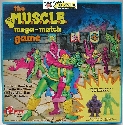
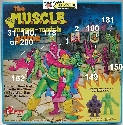


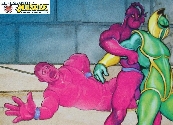
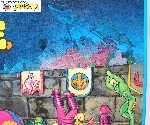
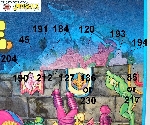
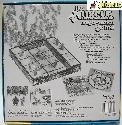
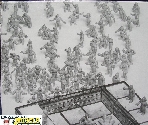
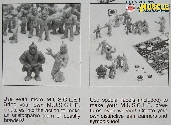
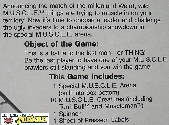
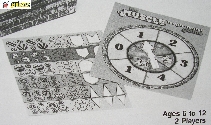
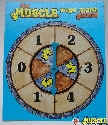
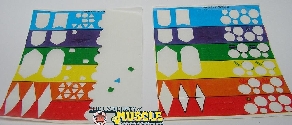
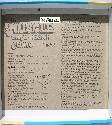
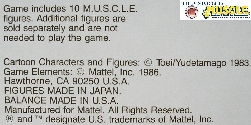
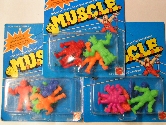
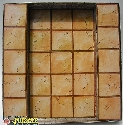
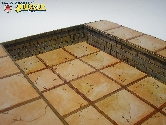
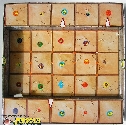
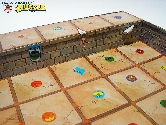
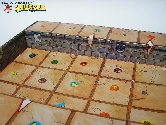
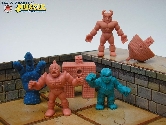
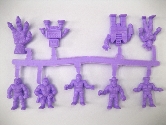
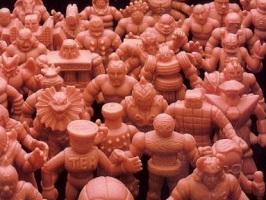
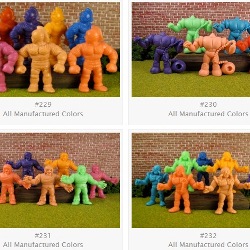
#1 by Clark on August 17, 2011 - 4:04 pm
the cover muscle holding the flag appears to be Theif George
#2 by Kris on September 8, 2011 - 12:52 pm
It could also possibly be #8 Shishikababu (Shishkebob)